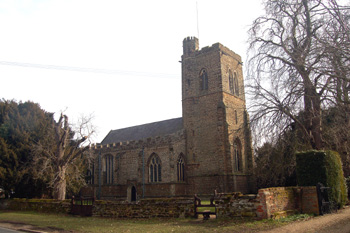
The church from the north-west March 2010
Most of the notes on the structural history of the church can be found in Bedfordshire Historical Record Society Volume number 77 of 1998 Bedfordshire Churches in the Nineteenth Century: Part I: parishes H to R, put together by former County Archivist Chris Pickford.
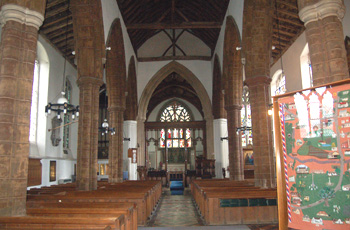
The interior looking east May 2010
Northill has a very full set of churchwardens' accounts dating from 1561 and ending in 1927, with some gaps [P10/5/1-4]. A set of inventories of church goods survives from 1605 and 1612 [P10/5/1], 1692 [P10/65/2], 1710 [Abe1], 1725 [P10/1/3], 1774 [P10/2/2/1], 1822 and 1841 [FAC99/1/45]. The first thing of note occurred in 1563 when the loft over the rood screen was taken down.
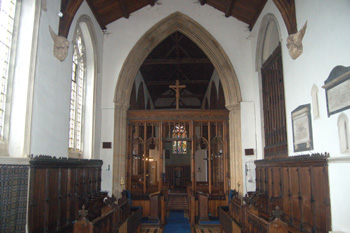
Interior looking west May 2010
The church had an organ in 1590 as the churchwardens' accounts [P10/5/1] note that some of the pipes were sold in that year. In 1602 a board with the Ten Commandments was set up in the church. Four of the five surviving bells were recast in 1580, 1589, 1602 and 1613 respectively. The bell-frame was renewed in 1637 and paid for by a special levy, which survives [P10/4/1], giving the names of parishioners of the time.
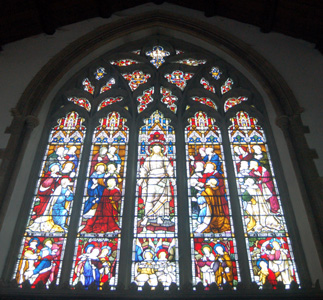
Chancel east window May 2010
In 1663 and 1664 the Grocers' Company, which had purchased the advowson at some time after 1652, paid for restoration of and improvements to the chancel. These involved the installation of painted glass by John Oliver in the east window, which then had three lights instead of today's five.
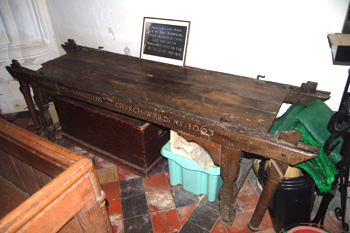
The parish bier May 2010
The parish chest is said to have been installed at the same time and the parish bier is certainly dated 1663. Perhaps most interesting is the possibility that the clock was installed in the tower in 1663. Local legend says that this clock was made by the great clock and watchmaker Thomas Tompion, who had been born in Ickwell. However, the first mention of the clock on churchwardens' accounts is not until 1708 [P10/5/2] and it may have actually been installed in 1706, as noted in the church terrier [ABE1]. Tompion died in 1718 and had been in London since at least 1670 but it is not impossible that the clock may be his work.
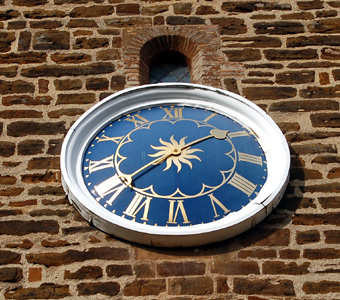
The clock on the south face of the west tower March 2010
Accounts note roof repairs in 1670 and a new weathercock in 1688. The church contained seats in the 1680s as "men's seats next the middle alley" are mentioned in accounts, as are those "where the maids sit" and "Mr. Harvey's seats". A sundial made by Edmund Culpeper was given to the church by Rev. James Calamy about 1685. It was removed in the 19th century and the plinth remains though the dial itself was lost or stolen.
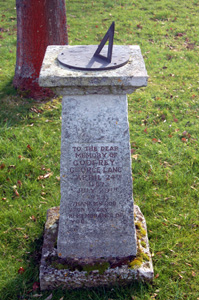
The sundial and remains of the 1827 font March 2010
In 1703 a thunderclap loosened a number of stones about the church and these were removed and repairs made. A bell was recast in 1711 and lead for the roof between 1737 and 1741. In 1763 a painting of a lion and unicorn over the chancel arch was touched up and other art work done. In 1760 the woodwork and lead on the chancel roof was repaired at the expense of the Grocer's Company [P10/1/4]. Around 1765 Lord Deloraine had a large private gallery built on the south side of the church [P10/1/8]. This was noted critically in an article by W. A. in 1847 [see below].
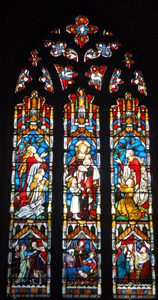
West window May 2010
In 1798 mason William Revitt repaired the tower which was "cracked from the top to the ground three sides of the square". Part of Revitt's repairs involved building a thick brick strengthening wall in the tower arch inside the church, blocking the view of the west window [P10/5/3 and 10/5/5].
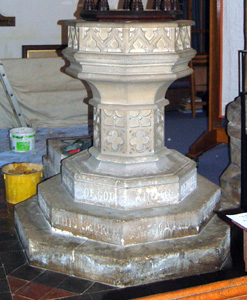
The font May 2010
A new basin for the font was bought in 1823 and £100 was spent repairing the seats and widows in 1825 [P10/5/4]. Two years later the bells were re-hung on new fittings. In 1827 the medieval font was replaced by a modern one [P10/5/4]. It did not last long, being replaced in 1858 by one in memory of the late rector, John Taddy. It is a copy of the font in Wymington church. The font of 1827 was then demoted for use as a plinth for the sundial donated by James Calamy about 1685. In 1832 and 1833 the lead on the nave roof was replaced by slates and the aisle roofs re-leaded at a total cost of over £200 [P10/5/4].
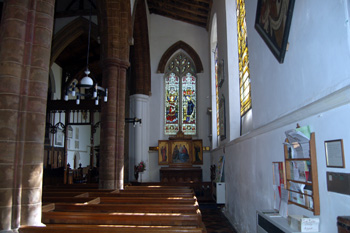
The south aisle looking east May 2010
The librarian of Woburn Abbey, John Martin, who styled himself WA, wrote a number of opinionated sketches of Bedfordshire churches for the Northampton Mercury. Here is the piece he wrote on Northill, published on 9th January 1847: "This noble collegiate church may be considered one of the finest specimens in the county, and if it is ever restored to its pristine beauty, will become an object of admiration to all who take an interest in the study of ecclesiastical architecture, as well as to those who rejoice in the restoration of the works of 'the men of those days who devoted all money, time, thought, hope, life itself, to raising for God to man, shrines as worthy of God as human hands could raise, and fit and able to lift man's thoughts and hope beyond earth, and lead it in heavenward'. In its present condition the chancel roof, walls and all, are whitewashed, and the eastern window principally filled with heraldry; sincere admirers as we are of painted glass, we would rather dispense with it, if only used as a display of man's pageantry".
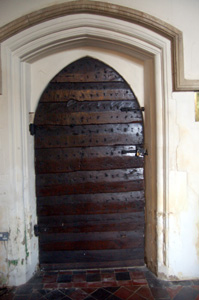
The north door May 2010
"A modern wainscot screen surrounds the altar and the adjacent walls, most probably concealing architectural ornament. Two or three ugly pews are in this part, erected in defiance of the sad relics of some fine stalls, whose restoration would be a matter of rejoicing".
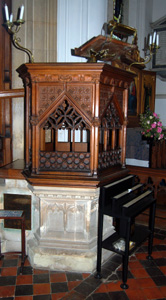
The pulpit May 2010
"The nave has a wooden roof, though we were informed that but for the interposition of the present incumbent it would have been ceiled. Pulpit, reading desk, and a box for that useless personage, the clerk, are of very inferior design. Open pews prevail, although there are several enclosed pews; one of the most capacious size as a large sheet thrown over it, testifying, we suppose, that whatever might be the fate of the sacred edifice, this square bit, at least, was specially cared for. An execrable [brick wall], it is said, will be removed, and the western window, now blocked up, exposed to view - a beautiful piscina, if we recollect aught, is covered by green baize, though the white coat that concealed its details has been removed".
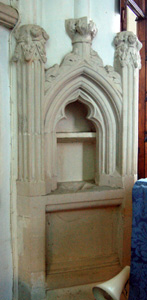
Piscina May 2010
"A goodly row of buckets, recorded as a gift of the Worshipful Company of Grocers, are suspended in the aisle. We trust a future visitor will have to notice some more befitting ornament of their liberality. If our feeble voice could reach the ears of the members of this ancient company, or at least of him who has recorded its history [Some Account of the Worshipful Company of Grocers by J. B. Heath] in a volume of great taste, we would venture to call attention to the condition of this noble building, the patronage of which is in their disposal. We would earnestly appeal for a new painted window in the chancel, having some reference to the sacred name to whom the church was dedicated by its pious founders, and the dispersion of the armorial bearings in the present window to the different windows of the aisles [it was indeed moved in 1885] and numerous other restorations which this church so loudly demands. It would add another grateful page to the future annalist of the company of merchant princes, and when the loving cup of their banquets passes round to its prosperity, the pleasure which is mingled in the recollection of their ancient splendour and munificent hospitality will be enhanced by the reflection that one of the noble monuments of their predecessors' piety is no longer crumbling into decay, but has by their liberality been restored to its former glory, and rendered a worthy place of worship and contemplation to those for whom it was erected".
![Northill church in 1859 [Z49/413]](/CommunityHistories/Northill/NorthillImages/Z49-413_350x252.JPG)
Northill church in 1859 [Z49/413]
A thorough restoration of the church began in 1862 at the direction of the rector and his architect Henry Woodyer of Guildford [Surrey]. The chancel arch was rebuilt and a new roof and floor of the chancel provided together with a stone reredos, a new vestry, an organ chamber, new seats in the nave and restoration of the tower, removing Revitt's sixty four year old wall and restoring the view of the west window from inside the church. The leaded spire was removed from the tower. The church was reopened in February 1863 [P10/2/2/3-5].

The lych gate March 2010
A gale damaged the tower in 1873 necessitating further repairs. A new lych gate was erected in 1880 and the present pulpit installed in 1882 - both designed by Arthur W. Blomfield.

South aisle south wall west window May 2010
The windows at the west end of the church were filled with Clayton and Bell stained glass in the 1870s and in 1885 the east window was given its present form, the old Grocers' Company glass being removed to the south aisle [DSA2/1/187]. The bells were re-hung in 1896 [P10/2/2/6] and the organ repaired the following year. A memorial window for John Harvey (died 1879) was installed in 1897, stained glass by C. E. Kempe [DSA2/1/187].
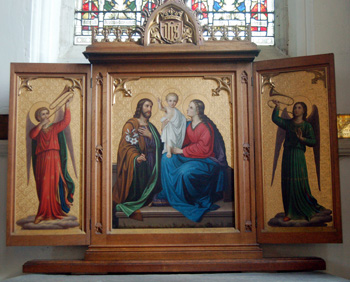
Chapel triptych May 2010
In 1904 the Astell memorial chapel was outfitted by Bucknall and Comper with woodwork by Rattee and Kett of Cambridge, altar by Jones and Willis [P10/2/2/7]. The Astell in question was Henry Godfrey Astell. In the same year the Leatham memorial window by C. E. Kempe was installed. A new organ was installed in 1921 [P10/2/2/8]. The tower was restored by Professor Albert Richardson in 1932 [P10/2/2/10-11] and a sixth bell hung in 1948.